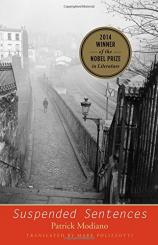Suspended Sentences: Three Novellas
Review
Suspended Sentences: Three Novellas
Consider the task of the 18-member Swedish Academy, the body that hands out each year’s Nobel Prize in Literature. From among the thousands of celebrated living authors at work around the world, the Academy picks only one to honor each year. A criticism often leveled at the Academy is that they’ve bypassed many great writers over the years. But how could they not miss big names with only one annual award to give out? This doesn’t stop the complaints about some of their choices, however, especially when they honor a relatively obscure writer.
Most readers in the US were surprised by the Academy’s choice of Patrick Modiano as the 2014 laureate. Few of his works have been translated into English. In his native France, however, Modiano has been a literary superstar since the release of his first novel, 1968’s LA PLACE DE L’ETOILE, written when Modiano was 23. He had become so famous by the early ’70s that the director Louis Malle hired him to co-write the screenplay to 1974’s Lacombe, Lucien, a brilliant, unsettling film about a 17-year-old Frenchman who joins the Nazis during the Occupation after the resistance movement turns him down.
"I suspect many readers will enjoy this fascinating portrait of postwar France from an author worthy of the attention the Nobel has given him."
The supposition when the Academy chooses an author Americans haven’t heard of is that his or her work is politically significant, difficult, and not much fun to read. Fortunately, Modiano’s writing is accessible, as SUSPENDED SENTENCES makes clear. The three novellas in this collection, beautifully translated by Mark Polizzotti, were written as separately published works between 1988 and 1993. Modiano’s main theme is the plight of French citizens in the two decades after World War II as witnessed by a young man who, like Modiano, was born in 1945.
Modiano’s father was arrested during World War II, and the fathers in two of the pieces in this collection, the title story and “Flowers of Ruin,” were imprisoned by the Nazis in the Drancy transit camp before a man named Louis Pagnon, a member of the Rue Lauriston resistance gang, got him out. This is one of several autobiographical touches in the book.
Each story is a remembrance, with the present-day narrator reflecting upon his experiences and the people he knew from the 1950s and 1960s. In the first story, “Afterimage,” the 19-year-old narrator, an aspiring writer, meets the photographer Francis Jansen, who knew Robert Capa before the Nazi invasion and who now harbors plans to move to Mexico. The narrator, fascinated by the older man, offers to catalog the photographs Jansen has taken over the past 25 years and, in the process, uncovers mysteries about the photographer’s life and his relationship with, among others, the real-life actress Colette Laurent.
The title story is about 10-year-old Patrick, nicknamed Patoche, who, with his younger brother, is sent to live with several women, among them a former acrobat and an older woman who calls him a “blissful idiot,” while his actress mother is on tour with a play. Friends who visit the house are connected to the same Rue Lauriston gang that rescued the narrator’s father, as are characters in the final story, “Flowers of Ruin,” in which the aspiring-writer narrator tries to uncover the mystery behind the 1933 murder-suicide of a young husband and wife.
Despite what you may have read, Modiano’s prose isn’t especially Proustian. Writing about remembrances doesn’t make you Proustian any more than writing about young love makes you Shakespearean. There’s more plot here than in Proust, and Modiano’s sentences are short and straightforward. A better comparison is to the autobiographical novels of a different Marcel, Marcel Pagnol, who wrote about his childhood memories in MY FATHER’S GLORY and MY MOTHER’S CASTLE. The prose in Modiano’s existential crime stories is spare but with many lovely details, including schoolyards paved with coal slag and a man “whose hair was so thick with pomade that it left stains on the couches and walls.”
There’s a lot of repetition here: Modiano lists street names often and reminds us over and over of the clothes characters wear and the cars they drive. This adds to the hypnotic effect. Some readers may weary of the excessive attention to Paris’s geography, and those who prefer linear plots and neat resolutions may be frustrated. But I suspect many readers will enjoy this fascinating portrait of postwar France from an author worthy of the attention the Nobel has given him.
Reviewed by Michael Magras on December 3, 2014
Suspended Sentences: Three Novellas
- Publication Date: November 11, 2014
- Genres: Fiction
- Paperback: 232 pages
- Publisher: Yale University Press
- ISBN-10: 0300198051
- ISBN-13: 9780300198058




